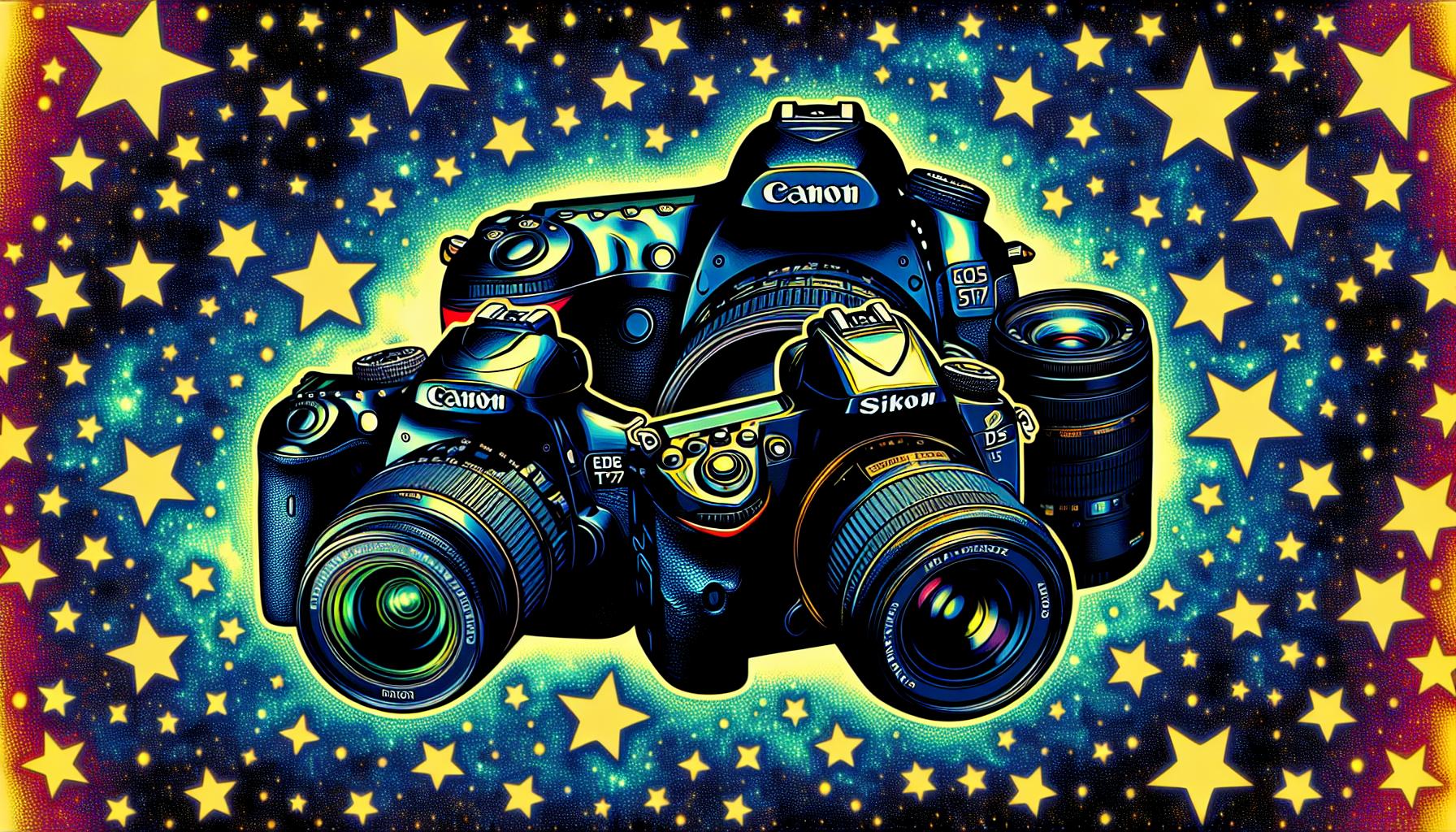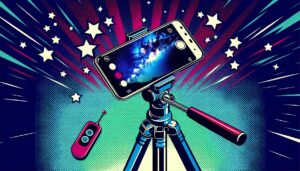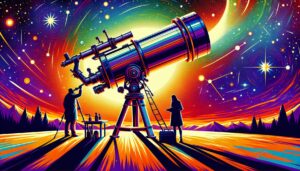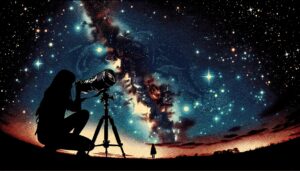This site contains affiliate links to products. I may receive a commission for purchases made through these links.
Astrophotography is a fascinating hobby that’s gained significant traction in recent years. It’s the art of capturing the beauty of the universe, and with a beginner DSLR, you too can get started on this exciting journey.
Choosing the right DSLR for astrophotography can be a daunting task, especially for beginners. But don’t worry, I’m here to help you navigate through the world of cameras, sensors, and lenses.
In this article, we’ll explore some of the best beginner DSLR cameras for astrophotography. We’ll delve into their features, pros and cons, and what makes them stand out in the crowd. So, whether you’re a novice or an amateur astronomer looking to upgrade your equipment, you’re in the right place.
Why choose DSLR for astrophotography?
You might be asking yourself, why should I go for a DSLR for my astrophotography venture? It’s a valid query which I’d like to help clarify with a few key reasons.
First off, DSLR cameras excel at low-light photography, making them a top pick for shooting celestial objects. They’re equipped with large sensors that absorb more light. This means you can capture stunning images of galaxies, stars, and other astronomical phenomena.
Additionally, DSLRs offer flexibility in settings and equipment customization. I can’t stress enough how important it is to have control over your camera’s settings when it comes to astrophotography. With a DSLR, you’ll be able to manually adjust settings like aperture, shutter speed, and ISO to achieve the perfect shot. Moreover, you can switch your lenses to something more suited for capturing distant objects, something not possible with most compact cameras.
Of course, it doesn’t hurt that a DSLR’s image quality is generally superior to that of other cameras types. When you’re capturing the intricate details of the universe, you’ll appreciate the exquisite detail and clarity a DSLR camera can offer.
Last but certainly not least, DSLR cameras are known for their durability and longevity. Astrophotography requires patience, time, and often, a bit of roughing it in the great outdoors. With a DSLR, you’ll have a sturdy piece of equipment that’s designed to withstand various conditions and last you a good long while.
While there are other types of cameras out there, DSLRs have proven themselves time and again in the world of astrophotography. But it’s important to remember that your camera is just one part of the equation. Your skill, perseverance, and passion in astro-imaging are what truly transform celestial wonders into breathtaking photographs.
Factors to consider when choosing a beginner DSLR for astrophotography
Knowing that DSLR cameras excel at low-light photography is important, but it’s not the only thing to keep in mind when selecting a beginner DSLR for astrophotography. You’ll also want to consider factors such as sensor types, ISO range and lens compatibility.
Choosing a camera with a large sensor is beneficial, as these absorb more light and can capture clear images of celestial bodies. Full-frame sensors are ideal, as they offer the largest size and therefore the most light absorption. Yet, for those just getting started, a crop sensor might also do the trick just fine. It’s important to remember that while a larger sensor can deliver better images, it often comes with a higher price tag. So balance your budget and image quality expectations.
The ISO range is another critical factor. This allows you to control the camera’s sensitivity to light. A higher maximum ISO means the camera performs better in darker conditions, essential for astrophotography. Ideally, look for a DSLR with a wide ISO range. If you’re shooting in truly dark conditions, consider models with ISOs that go up to 1600, 3200, or even 6400.
Finally, consider lens compatibility. Interchangeable lenses offer great flexibility, enabling us to adapt to different scenarios – wider fields for capturing the whole sky or narrower ones for zooming into specific planets or stars. Verify the body of the chosen DSLR is compatible with a wide variety of lenses, offering you the flexibility you need.
Remember, it’s not just about the DSLR camera, but also the dedication, skill, and creativity you bring to your astrophotography journey. These factors are a guiding light in your quest for capturing the cosmic wonders above us. And as you grow more experienced, you’ll find that even the constellations are the limit.
Top beginner DSLR cameras for astrophotography
Stepping into the world of astrophotography can seem daunting, especially when it comes to choosing the right DSLR camera to start with. There are quite a few amazing beginner-friendly DSLR cameras out there, and we’ll take a look at a few top choices.
The Canon EOS Rebel T7i, is an excellent DSLR for beginners. It supports a broad ISO range, up to 25600, making it highly sensitive to light, an essential attribute for low light photography. It utilizes APS-C size sensor, which coupled with Canon’s advanced imaging technology, provides a good balance between cost and effectiveness.
Next is The Nikon D5600. A relatively affordable entry-level DSLR that boasts an impressive 24.2 Megapixel DX-format CMOS sensor and an ISO range of 100-25600. It bolsters compatibility with a broad range of Nikon lenses, offering you the flexibility to switch lens configurations based on your requirements.
Lastly, we have The Sony Alpha a68. Though technically a DSLT (Digital Single Lens Translucent) rather than a DSLR, the Alpha a68 merits inclusion due to its stellar performance in low light conditions. Sporting an APS-C sensor and a maximum ISO of 25600, this camera is capable of capturing beautifully clear images of the cosmos. Moreover, Sony’s strong lens catalog grants you a lot of freedom when it comes to choosing lenses.
Here is a quick comparison of the specifications:
| DSLR Model | Sensor Type | ISO Range | Price Range |
|---|---|---|---|
| Canon EOS Rebel T7i | APS-C | 100-25600 | $700-$900 |
| Nikon D5600 | APS-C | 100-25600 | $600-$800 |
| Sony Alpha a68 | APS-C | 100-25600 | $600-$800 |
While these are solid starting points, remember that equipment is just part of the equation. Your dedication, skill, and creativity will also play a huge role in capturing astounding astronomical images. Now, let’s move on to discuss more on how to perfect your astrophotography skills.
Canon EOS Rebel T7 vs Nikon D3500: A comparison
Among various beginner DSLR cameras for astrophotography on the market today, the Canon EOS Rebel T7 and the Nikon D3500 are particularly noteworthy choices. Let’s delve into a head-to-head contrast of these two popular models.
The Canon EOS Rebel T7 is a top-notch DSLR for newcomers, mainly due to its impressive resolution. It flaunts a 24.1-megapixel APS-C CMOS sensor that offers superb detail despite the darkness of the night sky. On the other hand, the Nikon D3500 is also equipped with a comparable 24.2-megapixel sensor highlighting tight competition in image quality. It’s a tried-and-true tool in the hands of a dedicated astrophotographer.
Constructed to deliver quality images in low-light situations, the Rebel T7 employs an ISO range of 100-6400 (expandable to 12800). Yet, it faces stern competition from the Nikon D3500 which offers the same ISO range.
To add up to this, let’s compare the autofocus (AF) system. The Canon Rebel T7 carries a 9-point AF system which might seem rudimentary but does its job effectively under starlit skies. Comparatively, the Nikon D3500 stands a step ahead with an 11-point AF system for more precise focusing on celestial bodies.
Ease of use is also an important criterion for beginners. Both cameras have user-friendly interfaces and various modes for different shooting conditions. However, the Nikon D3500 tempers high performance with an easy-to-master intuitive control layout. The Canon Rebel T7, while slightly more complex, provides a broader depth of customizability appealing to those who enjoy learning ins and outs of their equipment.
In terms of pricing, these DSLR cameras fall within a similar range, making the decision purely focused on the camera’s functionalities and the user’s personal preferences.
Now as important as the technical specs are, remember, it’s also about the right skillset. So let’s move forward and skill up your astrophotography game.
| Camera | Sensor | ISO range | AF System |
|---|---|---|---|
| Canon EOS Rebel T7 | 24.1 MP | 100-6400 (expandable to 12800) | 9-point |
| Nikon D3500 | 24.2 MP |
Sony Alpha a6000: The best mirrorless option
From our discussion of DSLRs like the Canon EOS Rebel T7 and Nikon D3500, let’s shift our focus to mirrorless cameras, widely appreciated for their compact nature. On top of our list is an excellent model – Sony Alpha a6000. This camera stands out by combining the best of both worlds: easy-to-use for beginners and impressive specifications for astrophotography.
At the heart of the Sony Alpha a6000 is a 24.3 MP APS-C sensor, slightly larger than those found in the previously mentioned Rebel T7 and D3500. A larger sensor allows more light, ensuring the capture of brighter and more detailed photos – essential for astrophotography. The camera also boasts a wide ISO range of 100-25600, adaptable to various lighting conditions.
Just as important is its autofocus system. The Sony Alpha a6000 features an advanced 179-point autofocus system ensuring crisp and clear photos of celestial objects. It’s exact, fast, and particularly useful in low light circumstances, such as capturing star-studded skies.
I’ll echo our previous sentiment here. A camera, even one as ideal as the Sony Alpha a6000, is a tool, and the photographer is the one using it. Mastery of camera functions and techniques are what produces stunning astrophotography.
Conclusion
Choosing the right DSLR for astrophotography as a beginner doesn’t have to be daunting. The Canon EOS Rebel T7 and Nikon D3500 are excellent entry-level options, offering great resolution, ISO range, and autofocus systems. For those open to mirrorless cameras, the Sony Alpha a6000 is a standout with its impressive specs. But remember, it’s not just about the camera. Your skills as a photographer play a vital role.
So, don’t forget to brush up on your techniques and make the most of your chosen camera. Ultimately, the best camera for you is the one that meets your needs and fits your budget. Happy shooting!
FAQ
How does the Sony Alpha a6000 compare to the Canon and Nikon DSLR options?
The Sony Alpha a6000, a mirrorless camera, offers advanced features like a 24.3 MP APS-C sensor and a 179-point autofocus system. Despite not being a DSLR, it is a valid option for beginners due to its wide ISO range and advanced autofocus system.
What factors should be considered when choosing a beginner’s camera for astrophotography?
Along with the technical specifications like resolution, ISO range, and autofocus system, it’s equally crucial to evaluate the user interface and various shooting modes. Additionally, the skills and knowledge of the photographer also play a significant role in astrophotography.
Is the user interface of a camera important for astrophotography?
Yes, a user-friendly interface is essential, especially for beginners at astrophotography. It allows photographers to better navigate and utilize the settings and modes available, thus facilitating a more effective photo capture process.




